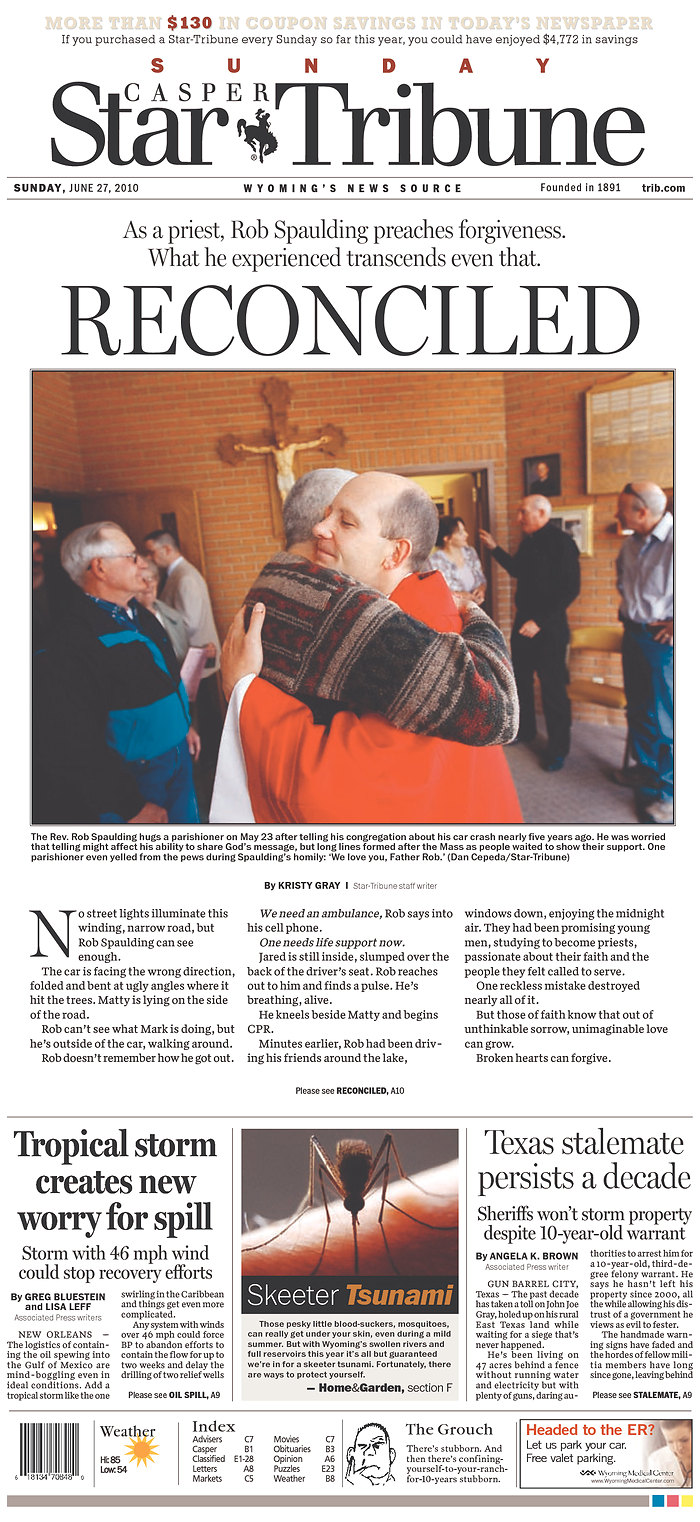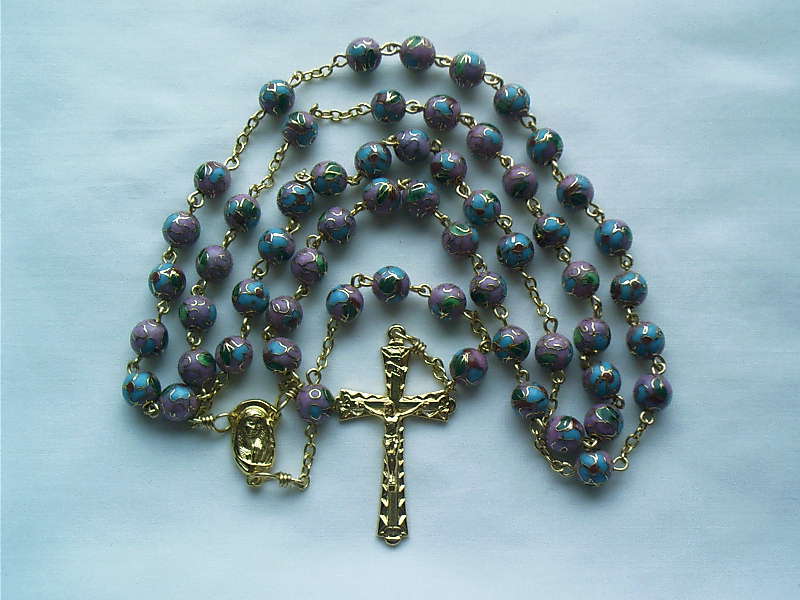A priest's rocky road to forgiveness (updated)
 Up in Wyoming, Casper Star-Tribune subscribers got their money's worth -- and more -- Sunday. Kristy Gray's remarkable story on a priest's journey from rock bottom to redemption dominated Page 1. The banner-size headline: "RECONCILED." I drank in every word of the piece -- all 4,400 of them.
Up in Wyoming, Casper Star-Tribune subscribers got their money's worth -- and more -- Sunday. Kristy Gray's remarkable story on a priest's journey from rock bottom to redemption dominated Page 1. The banner-size headline: "RECONCILED." I drank in every word of the piece -- all 4,400 of them.
To be sure, Gray's story is not perfect, and I'll raise a few concerns. But overall, this is the kind of story -- the kind of journalism -- that struggling newspapers could use a whole lot more of. Even better, from a GetReligion perspective, this story "gets religion" -- specifically the doctrine of forgiveness -- in a big way.
The best narrative stories hook the reader up high and give them reasons to stick around until the end. It's the journalistic equivalent of a soap opera, where each chapter solves one mystery but leads to another. The Casper Star-Tribune does just that, beginning with the scene around which the rest of the story revolves -- then going back and forward to fill in the blanks:
No street lights illuminate this winding, narrow road, but Rob Spaulding can see enough.
The car is facing the wrong direction, folded and bent at ugly angles where it hit the trees. Matty is lying on the side of the road.
Rob can't see what Mark is doing, but he's outside of the car, walking around.
Rob doesn't remember how he got out.
We need an ambulance, Rob says into his cell phone.
One needs life support now.
Jared is still inside, slumped over the back of the driver's seat. Rob reaches out to him and finds a pulse. He's breathing, alive.
He kneels beside Matty and begins CPR.
Minutes earlier, Rob had been driving his friends around the lake, windows down, enjoying the midnight air. They had been promising young men, studying to become priests, passionate about their faith and the people they felt called to serve.
One reckless mistake destroyed nearly all of it.
The basic storyline is this: Aspiring priest Rob Spaulding has a bright future ahead of him until he goes out drinking with three seminary friends, gets behind the wheel of a car while intoxicated and has a wreck that kills two of the students. Spaulding pleads guilty to three felonies and faces prison time until the mothers of the victims intervene, offering forgiveness to Spaulding and giving him a chance to rebuild his life -- and enter the priesthood after all.
In the background leading up to the crash, we find out about the path that led Spaulding to the seminary:
People expected him to go into business, marry his longtime girlfriend and spend summers camping and fishing with his children in Wyoming's mountains.
But in Laramie, Rob saw the full power of a faithful community. In 1998, UW student Matthew Shepard was pistol whipped, tied to a fence and left to bleed on the prairie. As a member of the Newman Center's pastoral staff, Rob felt the church reach out and pull students together, to heal through one another.
In 2002, he enrolled in seminary at St. Mary of the Lake in Mundelein, Ill., near Chicago -- 1,000 miles from Wyoming. Instead of cowboy bars, Mundelein has neo-Georgian architecture. Instead of dusty pastures and huge skies, it has lakes and canopies of trees.
Rob decided to try it for one year.
He wasn't sure if he could commit his life to the priesthood after his first year -- or after his second. During his third, in the spring of 2005, he completed a pastoral internship at St. Mary's Cathedral in Cheyenne, a chance to minister directly to people. In August, he chaperoned 180 Wyoming kids at World Youth Day 2005 in Cologne, Germany. The faith, fellowship and community Rob experienced there convinced him.
Later, the reporter provides a firsthand view of the forgiveness that victims' families bestowed on Spaulding:
People sometimes tell Rob that God must have had a reason. God must have needed Matty and Jared in heaven.
"I don't think that's how it works," Rob said. "God did not cause this to happen. I did.
"But God has been part of rebuilding it since the time of the crash."
In April 2006, Rob and his parents drove to Kansas. He met with Rick Cheek, Jared's father, Joan and then Pam. I am so, so sorry, he said to each one. (Note: Joan and Pam are the victims' mothers.)
He didn't expect forgiveness then, didn't ask for it.
But they all gave it.
What they did transcends forgiveness, Rob said. It crosses over into redemption and reconciliation -- standing eyelash to eyelash with the man who killed their sons and then inviting him to become part of their lives.
 I could copy and paste more passages from the piece that I really liked. This story is filled with delectable nuggets that made reading it a pleasure.
I could copy and paste more passages from the piece that I really liked. This story is filled with delectable nuggets that made reading it a pleasure.
But I do have a few criticisms.
At times, I wish the reporter had allowed herself to include a bit more skepticism.
It's mentioned twice in the piece that the future priest only had two drinks the night of the crash. Yet he and his friends were at the bar about 3 1/2 hours, and his blood-alcohol level content was 0.135 percent, almost twice the legal level, according to the story. I would have loved some confirmation from police or another expert that two drinks could have caused that blood-alcohol level.
Also, the story is told from the perspectives of the priest and the two victims' mothers. As best I can tell, the other survivor of the four seminarians who went drinking that night is not interviewed or quoted. I would have loved for that survivor's voice to be included, for him either to confirm Spaulding's version of events or raise doubts about it. At the least, it would be nice to know what happened to him. That potential source's omission from the piece seems like a hole, especially in a 4,400-word story.
Finally, I wonder if it is possible to "get religion" too much (did lightning just strike?). Seriously, at points in the story, I felt like readers needed to be Roman Catholics to truly understand what was happening. For example, consider this scene of one of the mothers by her dying son's bedside:
The hospital waiting room fills with friends, seminarians and Mundelein staff. Then, they crowd into the intensive care unit, breaking the two-at-a-time rule. No one from the hospital objects.
Joan waits late into the night. Her sister asks her archbishop to lead them in the rosary. Simultaneously, all of the people in the room reach into their pockets and pull out their beads.
"I believe in God, the Father Almighty, Creator of heaven and earth, and in Jesus Christ, his only Son ..."
I love that detail. I love that the story included that scene. I just wish that the writer had used a few words to explain "rosary" and the significance of the beads.
But those are minor quibbles.
Overall, this is a terrific piece of journalism -- one for which Gray and the Casper Star-Tribune should be extremely proud. By all means, read the story and let me know if you agree. What did I miss -- good or bad?
UPDATED: The writer, Kristy Gray, who is features editor of the Casper Star-Tribune, weighs in on a few questions I had about the story. Please see her responses in the comments section.